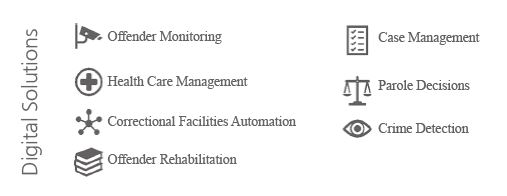Introduction – Moving the dial
The mission of corrections is a constant. However, the environment is which it operates is changing. Canada, like many other members of the Organisation for Economic Co-operation and Development (OECD) countries, is facing increased costs and increasing pressure from an offender population that that is ageing and requires more tailored solutions. The world of corrections is on the verge of significant change.
Decades of research has demonstrated that evidence-based risk assessment can lead to matched rehabilitation programs that significantly contribute to crime reduction. At the same time, advances in information technology and approaches to information management are enabling significant improvements in both risk assessment and intervention methodologies.
Within the broader corrections space, there are two available tools to manage this growing complexity: evidence-based reintegration policies and the effective use of technology. This paper provides a high-level discussion on the broader path for corrections and how digital technology, and more specifically Data Analytics and Predictive Analysis, will fundamentally drive change for corrections. This technology will offer solutions that will enable corrections in North America and Europe to rethink their role and the services that they provide.
Digital technology and the role of data analytics
One of the key defining factors of digital technology is the breadth of its scope. It addresses the integration points between an organisation and external platforms and can include technologies that fall outside of an organisation’s control. Perhaps the greatest challenge with moving towards digital is how everything becomes interrelated.
Recidivism reduction, a key metric of corrections success, is linked to the effectiveness of offender programs, which in turn depends on the accurate assessment of offender risk levels, recidivism, needs and reintegration potential. Traditionally the information used to assess offenders has been limited to data that is conveniently located and accessible on offender files.
Digital technology enables assessments to include more relevant information in a systematic method, which will lead to more accurate assessments that are tailored to the individual offender and their circumstances. In this way, digital technology has the potential to enable more precise referrals to rehabilitation programs and services, which will have a positive impact on public safety.
Assessing offenders to enable them to reintegrate into society as quickly as possible while maintaining the safety of the community is a complex ecosystem that the Canadian government must manage. It is at this point of convergence that digital technology has the greatest role to play.
At the heart of Digital lies the need for what has been coined “digital-grade intelligence” (DGI). The development of DGI is grounded in strong business and information governance programs, effective and scalable data management, and sophisticated advanced analytics capabilities. It is ultimately the backbone of an integrated view of data driving integrated correctional solutions.
Digital solutions drive change
Within the corrections space, digital technology and data analytics can drive a vast array of decision-making capabilities, infrastructure enhancements and automated services.
One of the most significant opportunities for corrections is the ability to predict behaviour and manage risk. Before we turn to this topic, it is worth mentioning a few other areas in which digital technology is having an impact on corrections. They include automation, healthcare and rehabilitation and crime prevention.

- Moving from predictable surveillance to dynamic supervision
Digital solutions have the potential to significantly reduce the workload demands of necessary but routine surveillance tasks that are part of a correctional officer’s daily functions. RFID, biometric scanning, and wireless technologies offer opportunities to better manage the placement and movement of inmates within correctional facilities in a more humane way while enhancing incident identification and prevention.
Redirecting correctional staff from routine surveillance functions would enable them to be deployed to areas of higher concern to prevent incidents, intervene with offenders effectively, and collect vital information that can improve the dynamic assessment of an offender’s risk to harm themselves or others. The redistribution of surveillance functions can also improve the quality of interventions with offenders outside of the penitentiary.
Automation is already applied to community supervision using electronic monitoring in many correctional jurisdictions. Kiosks that are accessible to offenders for information and requests are used today but are likely to evolve to more personalised solutions in the future.
In a vision of that potential future, offenders determined safe enough to qualify for community supervision could check in and report movements via mobile devices (cell phones or tablets) that are verified through GPS and personal identity scanning technology. This data could be transmitted to a data-centre for ongoing monitoring and analysis, which would enable the ability to raise flags to indicate that an offender may require intervention or to trigger more restrictive supervision conditions.
- Health care management
Compared with the general population, inmates disproportionately suffer from a variety of serious conditions, including suicide rates three times that of the average population. With improvements to video conferencing and bio-analysis techniques, it will be possible to monitor and address inmate health remotely, reducing the need for on-site specialists and significantly improving health care.
This technology can be applied to both physical and mental illness and are likely to be particularly useful in reducing suicide attempts which, with better technology-enabled prisoner monitoring, become more predictable events.
- Offender rehabilitation
Preparing offenders for life in the community is key to reducing recidivism. Technology enables remote teaching, access to digital libraries, and self-managed rehabilitation, reducing costs while also potentially allowing inmates to better demonstrate the gains they have made once outside of the correctional institution.
Corrections organisations, within the OECD, have a long history of developing and implementing effective cognitive behavioural therapy (CBT) programs to offenders that significantly reduce recidivism. The merit of computerised CBT extends to its ability to be implemented in any setting (institution or community and using an individual or group format), they’re relatively cost-effective compared to other interventions, and a wide range of cognitive behavioural curriculums can be adapted into an online format.
There is also emerging evidence that people provide more information and are more forthcoming when interacting with virtual interviewers and counselors. The possibilities of augmented and virtual reality methods to improve behaviour may become significant in a world where even routine tasks are becoming gamified to improve engagement and retention.
A major determinant of the success of education and employment-related interventions will be secured access to the internet within penitentiaries. This will enable a wider range of online education opportunities. Recent evaluations have determined that education can play a role in reducing recidivism, particularly for higher-risk offenders.
Likewise, employment qualifications and job readiness will increase substantially with online vocational and recognised certification. Currently, offenders in penitentiaries have limited to no access to the internet and personal computers, which will increasingly place them at a disadvantage when reintegrating into the modern workforce.
Enabling modern digital communications within penitentiaries will also facilitate positive and prosocial community contacts and family support while controlling for security breaches. Digital solutions also offer methods of achieving a constitutionally compliant framework for the interception and management of inmate communication with the public through monitoring methods that would be otherwise prohibitively expensive.
At the very least, modern digital solutions will facilitate the timeliness of documentation and reports written about offenders, inmate access to information, access to legal research resources, and contact with the outside world.
Data analytics and predictive modelling – the real focus
Of all the digital capabilities, data analytics and predictive modelling will continue to have the most profound impact on corrections. And the reason is simple. Predictive modelling focuses on improving the assessment of risk and expected offender behaviour. More than any other area, this capability is expected to improve performance (increase public safety) and reduce costs (timely safe releases and the reduction of recidivism).
As with any profound shift in technology, when developing a new approach, diligence is required. Several lessons have been learned through previous implementations, both in the US and Europe. These lessons are important. First, transparency is key. Understanding how the algorithms are calculated and the parameters that are used to calculate them ensures transparency and the ability to assess their accuracy and identify unintended bias.
Second, decisions around incarceration and parole are significant ones. Making a balanced and informative choice is critical, and predictive modelling can improve fairness by reducing subjective discretion. Third, behaviour modelling does not replace human judgement. It is there to supplement and guide it.
Much more emphasis should be placed on how data analysis enables better human judgement. Data analytics and predictive modelling enable better risk assessments and decision making. If we look at the complexity of the decisions involving the conditional release under the supervision of an offender to a Canadian community, there are often more than 30 different parameters that factor into a decision. With so many factors to consider, human bias can easily enter the equation and hinder the decision-making process. The human mind is not equipped to gauge and evaluate so many parameters effectively and make judgements in an unbiased manner.
So where lies the balance? How do we better equip parole officers, managers, and parole board members to make better decisions, evaluate risk, improve public safety all while reducing recidivism? Ultimately, predictive analytics has a lot to offer as part of a broader toolbox that supports effective decision-making rather than driving it.
In summary, analytics, driven by policy and guided by sound judgement, is where the answer lies. So how does this translate into action? It means that data analytics can do a better job at identifying low-risk offenders for parole opportunities and help manage this risk within an acceptable tolerance. What is even better, these models will be able to recommend programs that will align with an offender’s needs, which will support their successful reintegration. All this, while reducing the broader community risk and driving down costs.
- Managing recidivism
Although the emphasis of this article is focused on the assessment and intervention to reduce recidivism, the use of predictive modelling is equally significant in its potential to reduce recidivism levels.
Correctional jurisdictions are typically the holders of vast amounts of descriptive data ageing the details of the crimes and criminal history of offenders. Data analytics will be able to sort through this historical information to help identify the variety of methods offenders have used to commit crimes and the circumstances in their environment that elevate the risk of crime.
When probabilities are assigned to these variables, just as they are routinely done today in commerce and marketing, the ability to solve crimes by discovering the most probable behaviours that criminals generally commit prior to crimes will be significant. Merging anonymised crime data with behavioural profiling data may significantly advance our methods of determining who the culprits of crime are.
Final remarks
Digital solutions are often viewed with skepticism, but they shouldn’t be. They have the potential to address a broad set of correctional opportunities with meaningful solutions that integrate health care, rehabilitation, the reduction of recidivism, improved risk assessment and the overall reduction of costs.
OECD countries are taking steps towards building these capabilities. They have already demonstrated that evidence-based content for correctional programs reduces crime. It will be technology that will enhance the business needs. Electronic monitoring of offenders under supervision in the community has been piloted and will undergo evaluation.
Video support and telemedicine for healthcare management is another digital solution that assists offenders. Improving offender access to education, literacy, and technology is also being pursued. Corrections is looking at implementing a new offender management system that will support this broader direction.
This journey is perhaps a long one, however steps have already been taken with the implementation of rigorous evaluation of evidence-based risk assessments and interventions. This serves as a strong foundation for digital solutions to contribute to the safety of communities.
//



// Simon Bonk is the Chief Information Officer at Correctional Service of Canada. In his role as CIO, he’s responsible for engaging with partners to identify opportunities where the enablement of technology and information management services can address business challenges.
Mr. Bonk’s expertise also lies in IT financial management, which helps to shine a light on how IT investments align with the mandate and priorities of the business.



// Michael Bettman is the Director General of Offender Management System Modernisation for the Correctional Service of Canada. He is the former Director General responsible for correctional (cognitive-behavioural) program development and implementation, case management, and social programs. He has a PhD in Psychology from Queens University and has dedicated his 30-year career to evidence-based criminal risk assessment and intervention.


